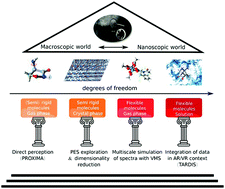Integration of theory, simulation, artificial intelligence and virtual reality: a four-pillar approach for reconciling accuracy and interpretability in computational spectroscopy
Abstract
The established pillars of computational spectroscopy are theory and computer based simulations. Recently, artificial intelligence and virtual reality are becoming the third and fourth pillars of an integrated strategy for the investigation of complex phenomena. The main goal of the present contribution is the description of some new perspectives for computational spectroscopy, in the framework of a strategy in which computational methodologies at the state of the art, high-performance computing, artificial intelligence and virtual reality tools are integrated with the aim of improving research throughput and achieving goals otherwise not possible. Some of the key tools (e.g., continuous molecular perception model and virtual multifrequency spectrometer) and theoretical developments (e.g., non-periodic boundaries, joint variational-perturbative models) are shortly sketched and their application illustrated by means of representative case studies taken from recent work by the authors. Some of the results presented are already well beyond the state of the art in the field of computational spectroscopy, thereby also providing a proof of concept for other research fields.

- This article is part of the themed collections: 2021 PCCP HOT Articles and PCCP Perspectives


 Please wait while we load your content...
Please wait while we load your content...